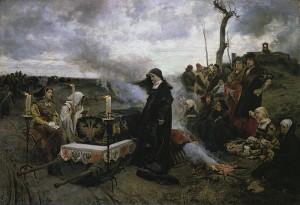By Elizabeth A. Lehfeldt (W&M Regular Contributor)
Imagine being known to history as Juana “la Loca” or Juana “the crazy one.” That is heavy baggage to carry forward from the sixteenth century into the postmodern era. Before she was Juana la Loca, she was Juana of Castile (1479-1555), the eldest surviving heir of the famous monarchs Isabel of Castile (r. 1474-1504) and Fernando of Aragon (r. 1474-1516). When her mother died in 1504, earlier marriage capitulations made it impossible for her father to inherit the throne, making Juana the rightful sovereign of Castile. Yet her ambitious father and her husband, Philip the Fair (1478-1506), sought to break this neat line of succession and push her off the political stage. In part, they used rumors of her instability to discredit her authority. When Philip died unexpectedly in the city of Burgos in 1506, Juana’s behavior unfortunately fueled the flames of her detractors. She insisted upon accompanying her husband’s funeral cortege across the Iberian peninsula from Burgos to his final resting place in Granada. Fernando presented this act of wifely devotion and other emotional outbursts as evidence of mental illness and advanced his own claims to the throne. He eventually forced her seclusion in a convent in the small town of Tordesillas.
Fernando presented this act of wifely devotion and other emotional outbursts as evidence of mental illness and advanced his own claims to the throne. He eventually forced her seclusion in a convent in the small town of Tordesillas.
Fernando died in 1516, leaving behind Juana and her son, Charles I (1500-1558), as his heirs. Despite her confinement, Charles continued to consult with her and maintained the pretense of joint rule with his mother. A group of urban leaders who were dissatisfied with Charles’ long absences from Castile and reliance on foreign advisers even appealed to Juana during a revolt they staged in 1520-21. Some clearly believed she could still exercise independent sovereign power.
But in the end, later generations would immortalize her for her presumed, but never proven, insanity. Juana’s plight captured the attention of nineteenth century Romanticists, for example, who sentimentalized her devotion to Philip in paintings like this one above by Francisco de Pradilla, produced in 1877. This haunting portrait speaks volumes about history’s distorted image of a misunderstood queen. In 2001 a Spanish movie, “Juana la Loca,” (translated for English-speaking audiences as “Mad Love”) perpetuated this interpretation of Juana’s instability.
Recent scholarship has sought to investigate the true character of Juana’s personality and exercise of political authority (see, for example, Bethany Aram, Juana the Mad: Sovereignty and Dynasty in Renaissance Europe, 2005). It reveals that she often rejected the power that she was entitled to, but she was not insane. At some moments she worked vigorously to assert her sovereignty and her control over her royal household. Only time will tell if interpretations like this are enough to rid Juana of the weighty baggage of being portrayed as a mentally unstable queen.
Elizabeth A. Lehfeldt is Chair and Professor of History at Cleveland State University. She writes on the history of gender in premodern Europe.
